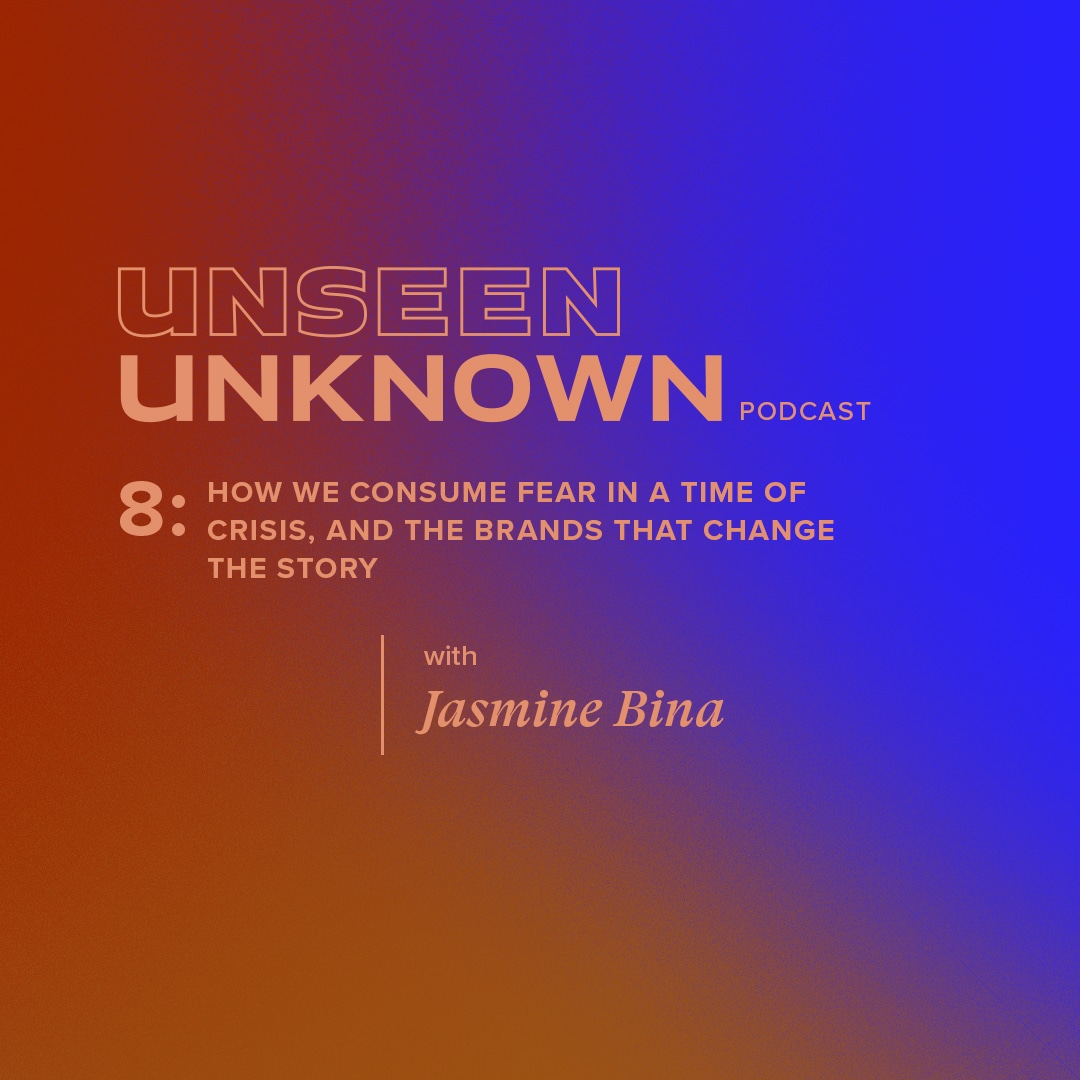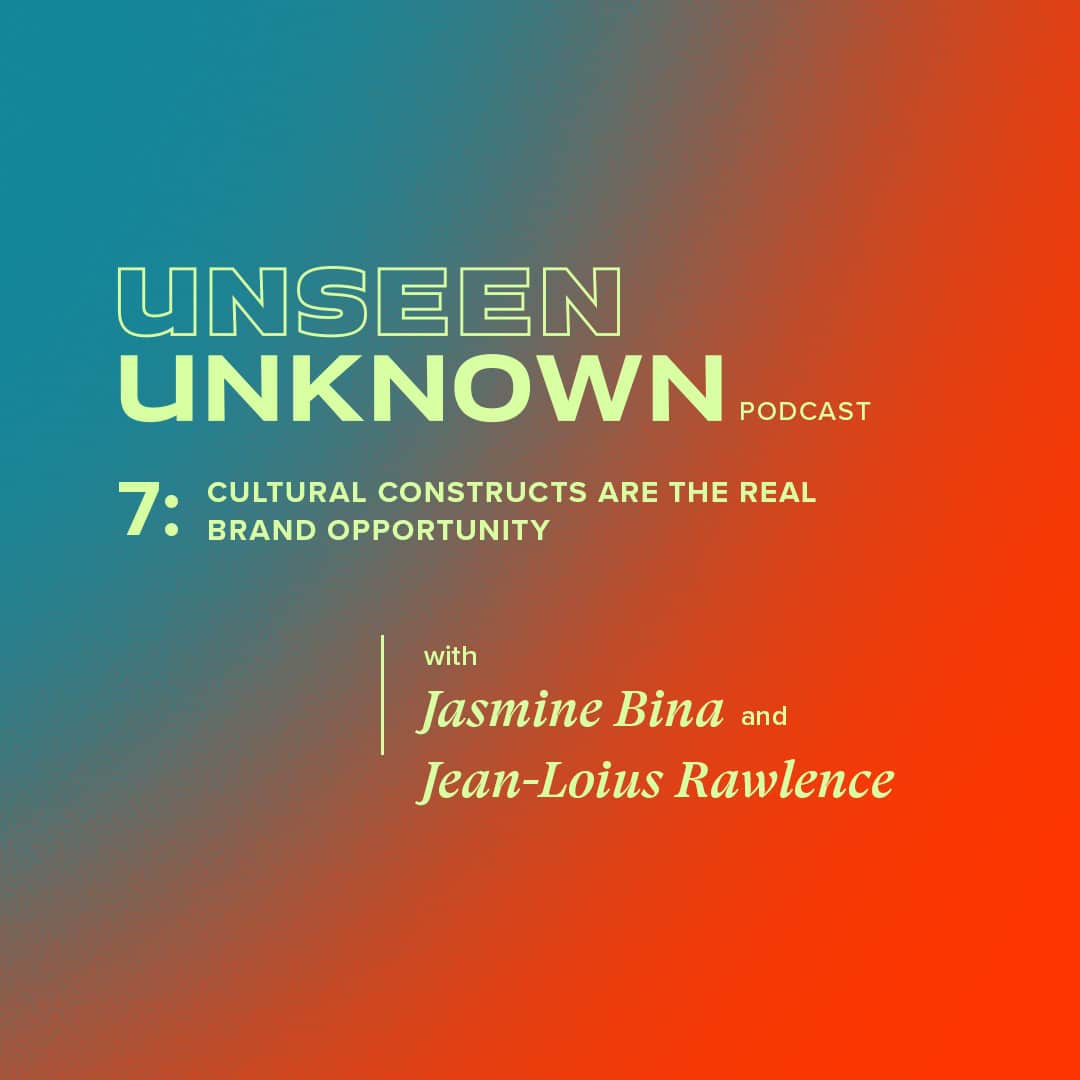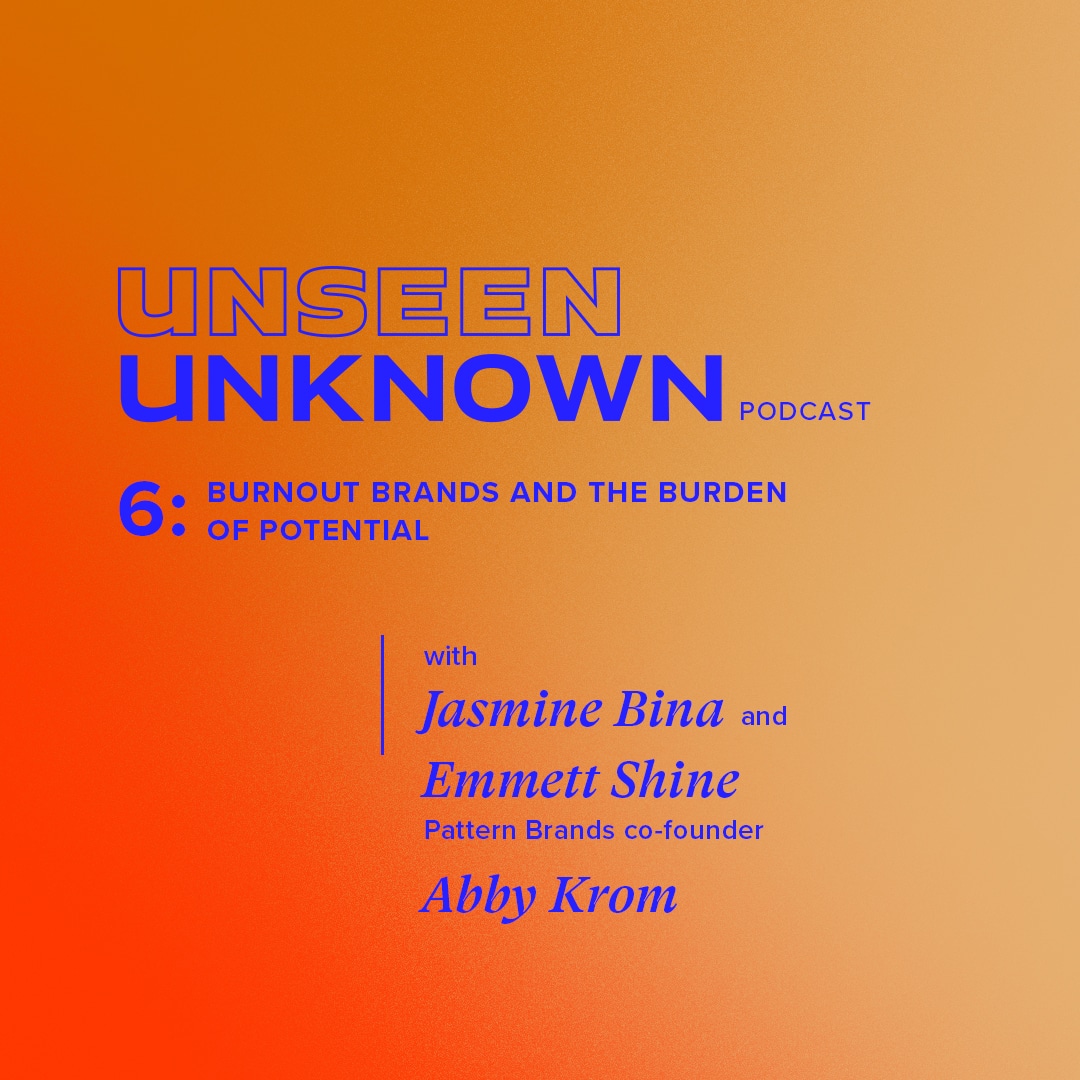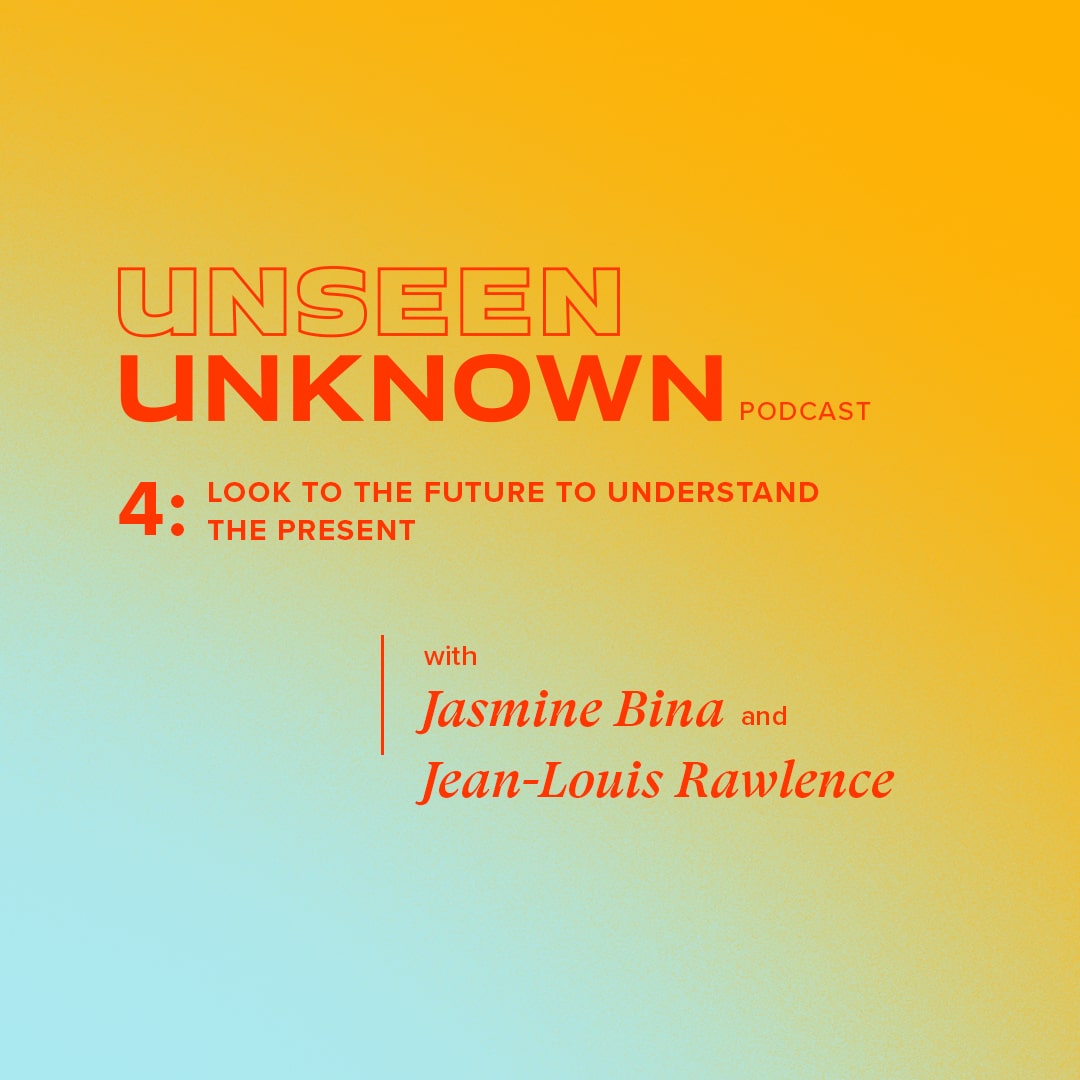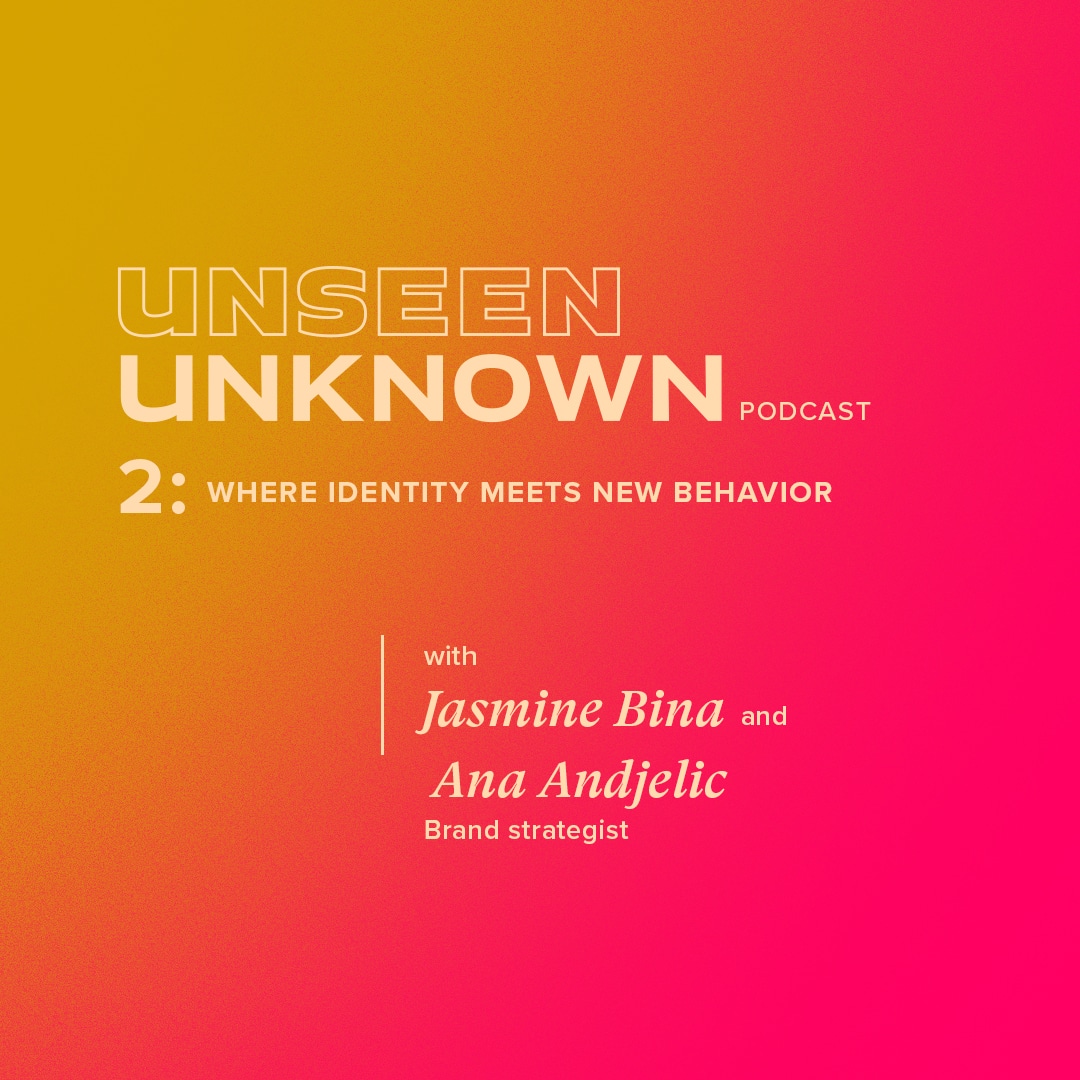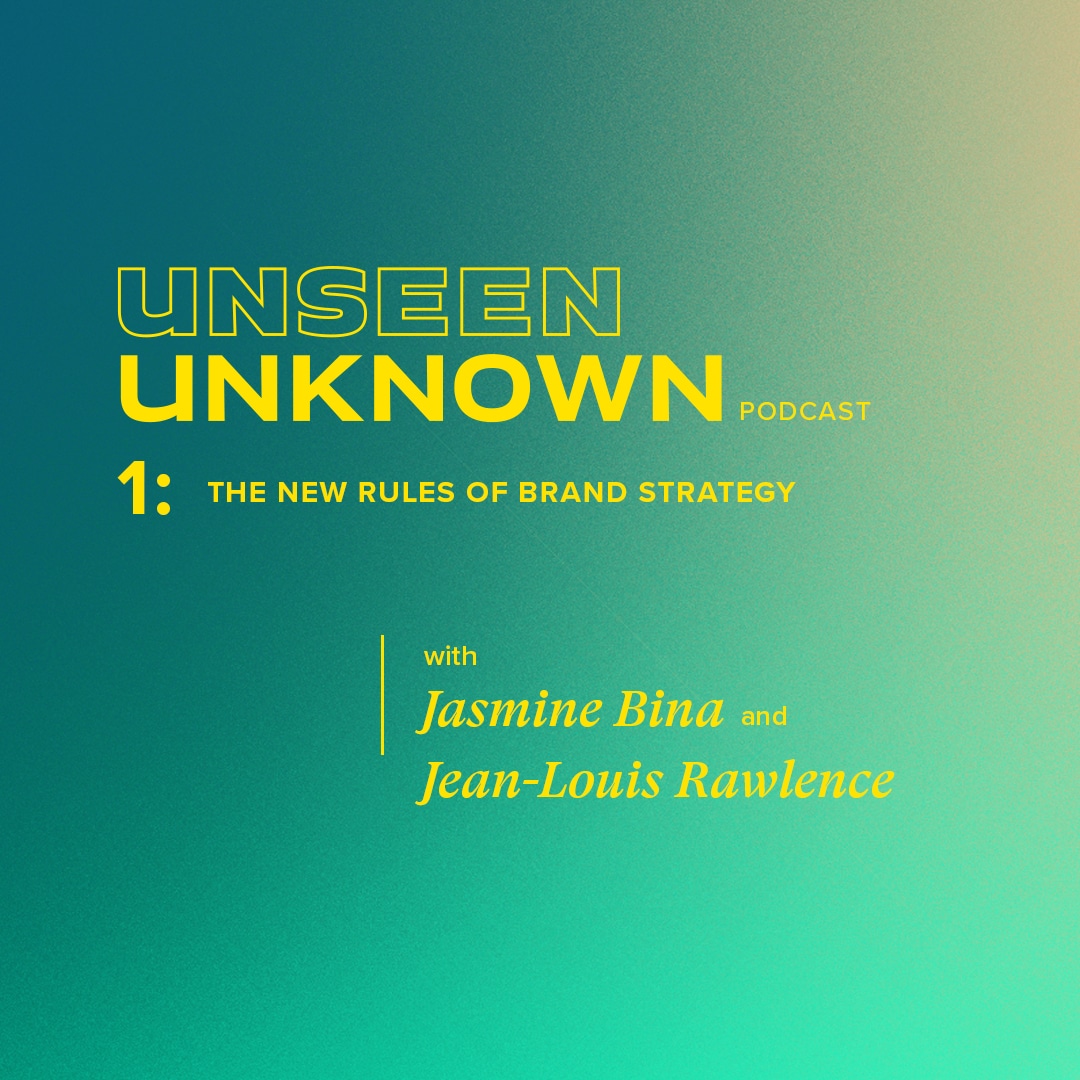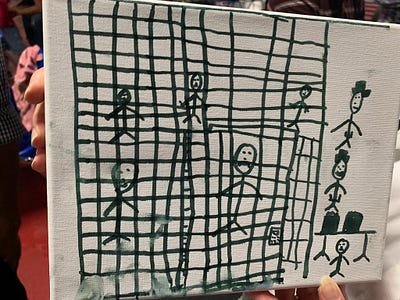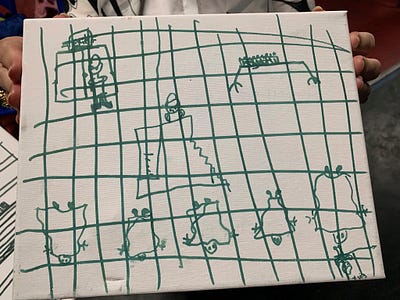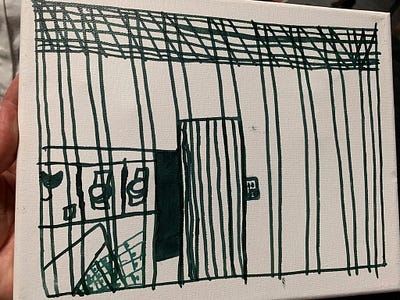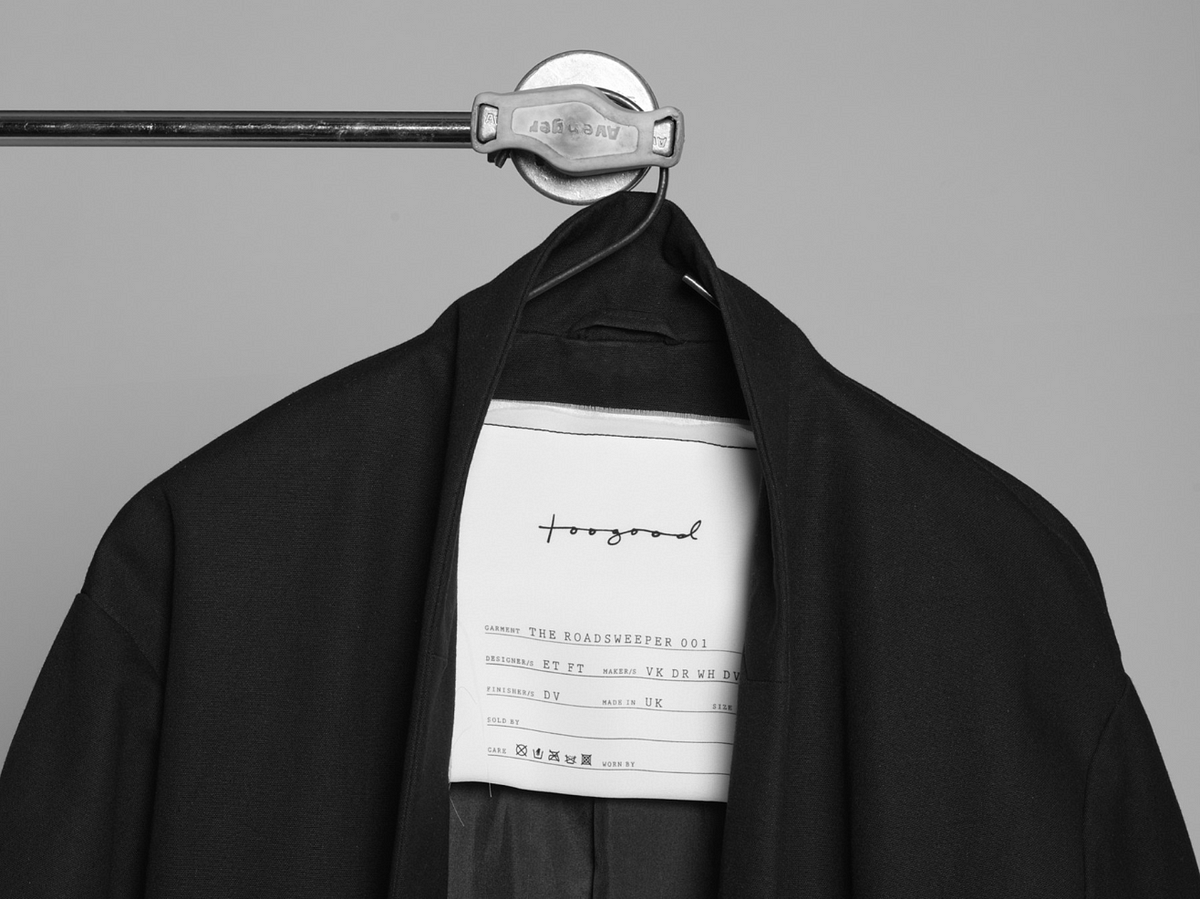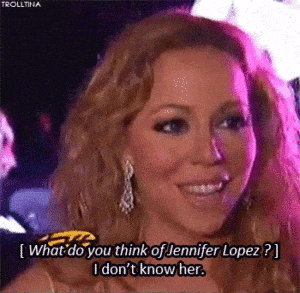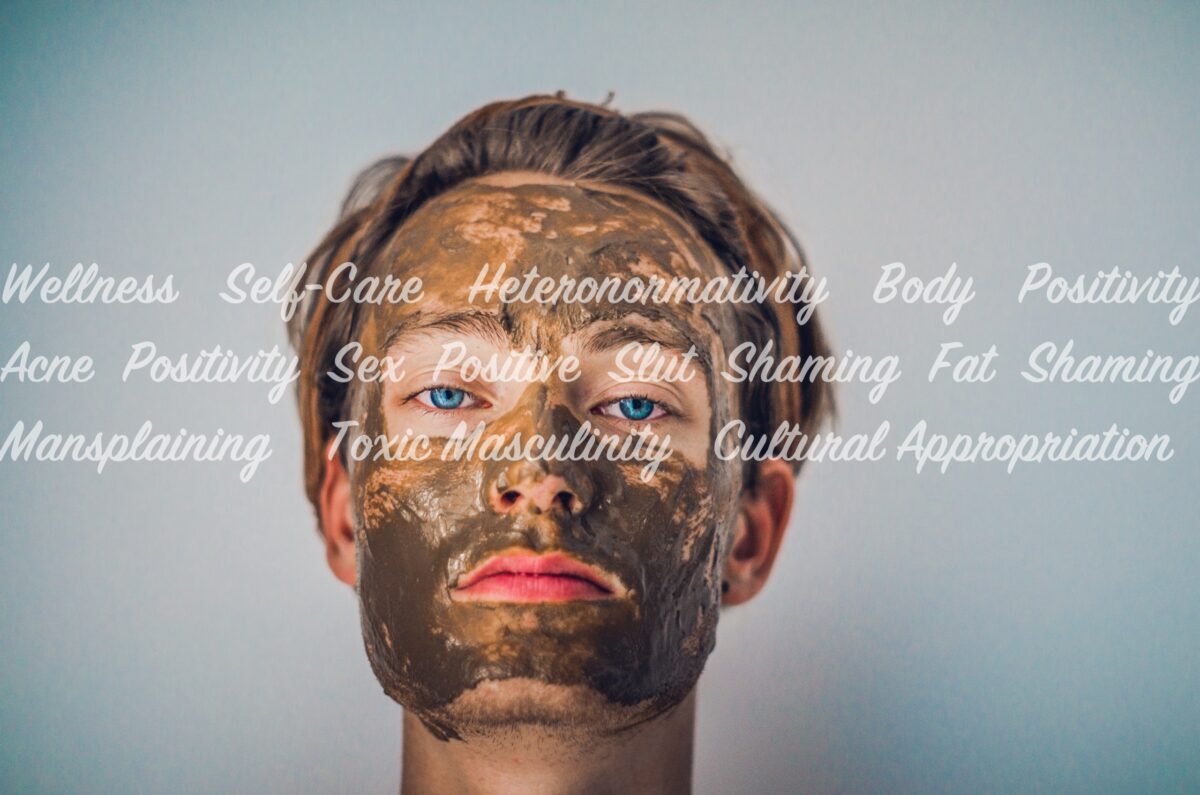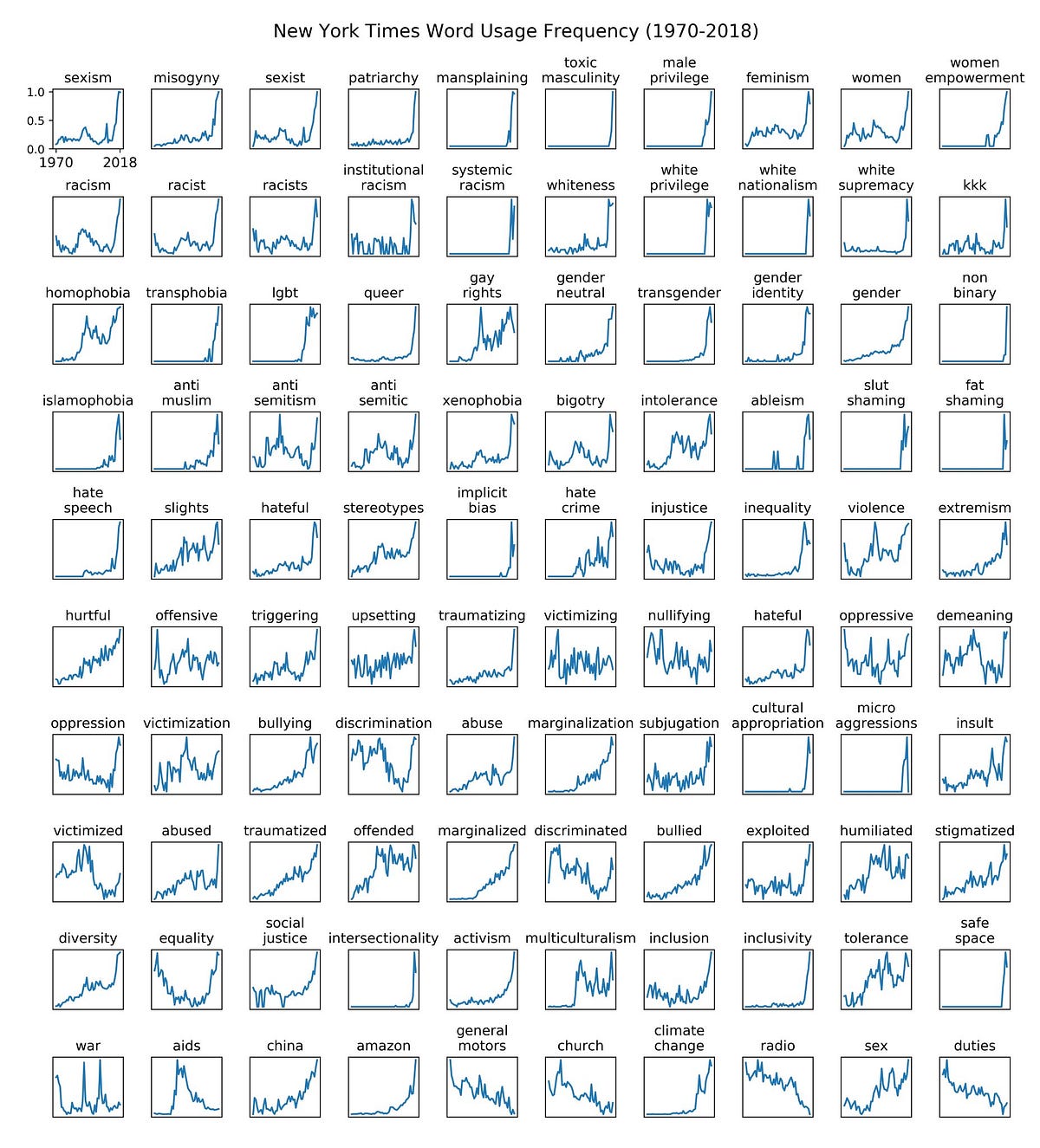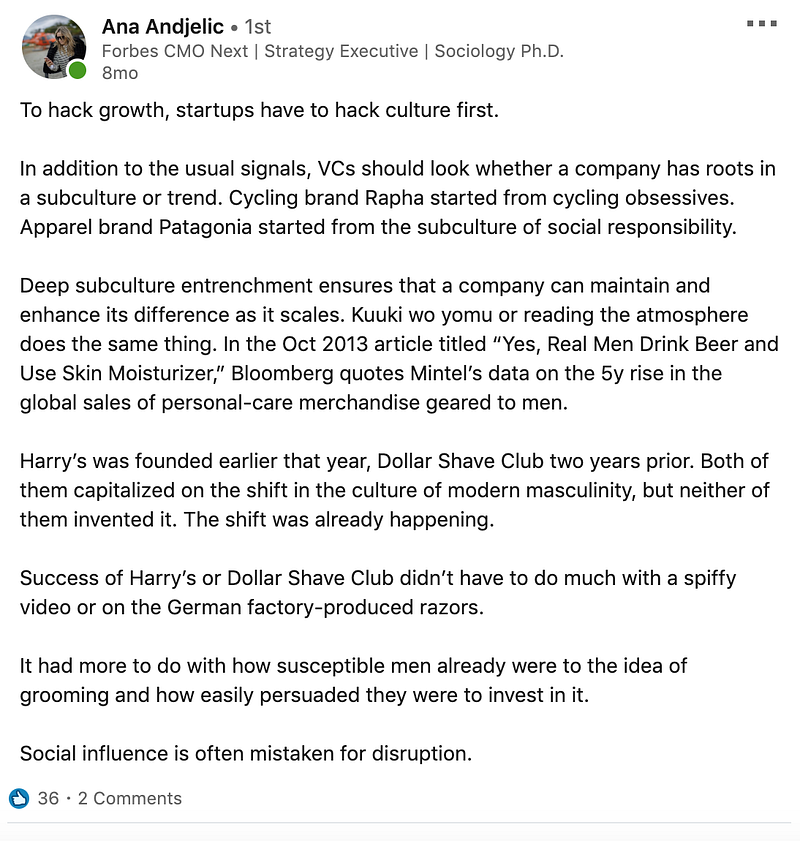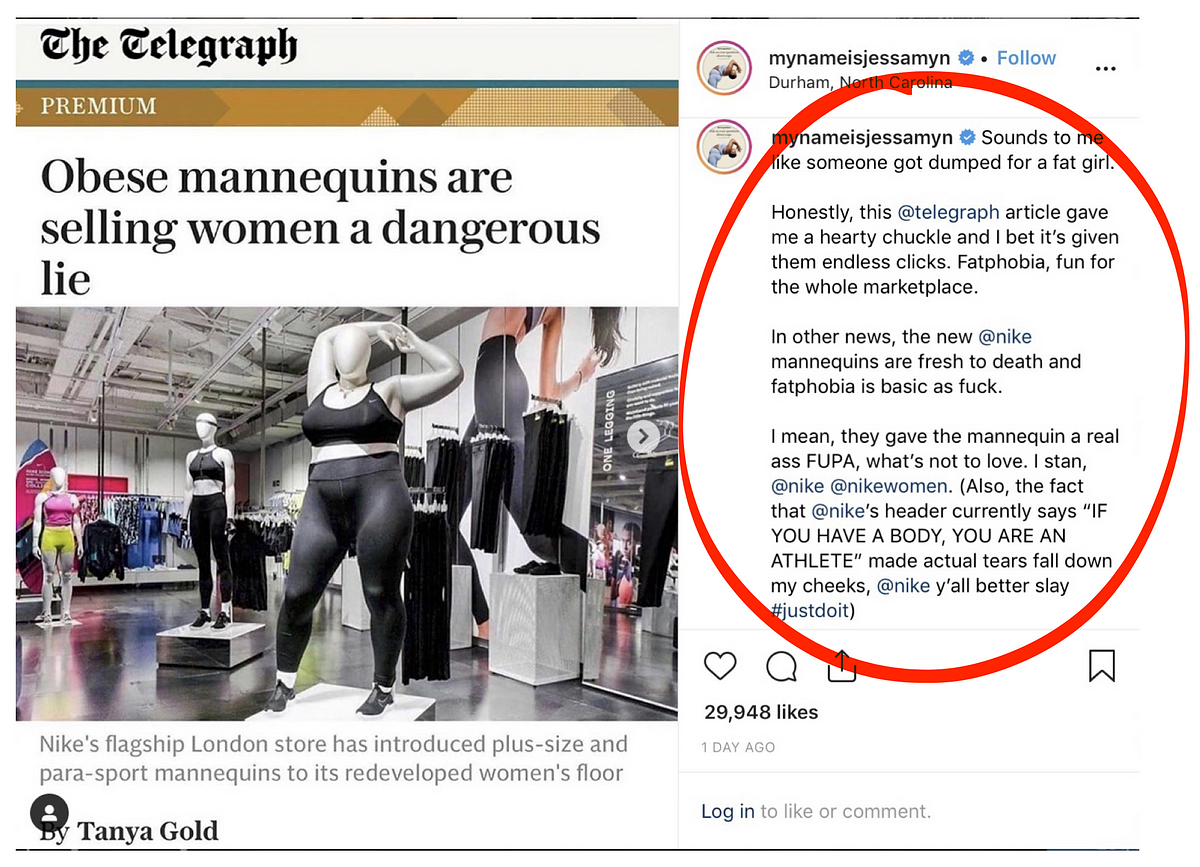Podcast Transcript
March 19, 2020
50 min read
Celebrity Culture, Platform Brands and Parasocial Relationships
00:00
Jasmine Bina:
Welcome to Unseen Unknown, I’m Jasmine Bina. A quick programming note before we start our episode today, considering what an uncertain time it is in the world right now, in the added layer of complexity that comes with things like coronavirus and social distancing, and a volatile market, and an election year, we’re dedicating this episode, and the next few episodes of the show to business topics that can help us make sense of the current climate, both in branding, and perhaps even more importantly in our personal lives.
We’re going to explore topics like loneliness, the emergence of anxiety culture, optimism in times of chaos and survival stories, which applied to both business and to culture. Each episode will help you understand brand strategy and yourself on a deeper level. Jean Louis and I hope these discussions can provide some meaning as we navigate the future together.
00:47
Costco is one of the only retailers doing really, really well with millennials right now. And that’s largely for two reasons. One, they’re extremely smart and responsive in how they stock trending products that people are actually willing to buy. And two, Costco actually spends a lot of time and a lot of money to make their stores look like Bare Bones warehouses. That’s not by accident, those warehouses don’t just pop up like that. The warehouse feel is actually very much by design and it’s become a haven for people that are looking to stock up on vegan superfood creamers, and paleo pancake mix. The abundance of product which is just stacked on pallets that reach up to the ceiling, this has a framing effect.
It’s a carefully crafted environment that makes you see your impulse buys, not as superfluous purchases, which they may very well be, but rather as pantry staples. Buying premium products in large amounts makes you feel good and safe. But Costco has felt very different lately in the wake of the coronavirus and a stampede of people to shore up on items in the face of a very uncertain and unnerving period of social distancing, aisles have gone empty.
02:06
Jasmine Bina:
So I think it’s here.
Co-shopper (audio clip):
Yeah.
Jasmine Bina:
This is where it would have been.
Co-shopper (audio clip):
That’s creepy. It’s all gone.
02:14
Jasmine Bina:
So we’re literally in the toilet paper and water bottle aisle of Costco, which would usually go up to the ceiling and there’s absolutely nothing here. The crates are gone. It’s like five cases of water that people are taking up right now. And that’s it, there’s nothing else here. As we kept walking, we saw there were no frozen fruits, no frozen vegetables, door after door the cases were empty, empty boxes everywhere, no potatoes, no sweet potatoes, definitely nobody handing out samples. Costco felt like it had been ransacked. The sense of safety had been replaced with an uncomfortable reality that sometimes felt funny, but really most of the time felt alarming. We spoke with an employee who said, “Despite nightly restocking shelves would be emptied out by 9:30 AM.”
Store employee (audio clip):
So, I haven’t been here for before, like when they opened today, but just for the last couple of weeks or so. The lines have been going just basically around the whole lot. And then everyone’s just buying like before, there was no restrictions on water and toilet paper. So everyone’s just buying maybe like a full flatbed full of waters. And then once people figured out, there was no water, I think it starts slowly starts to die out and they go somewhere else.
03:31
Jasmine Bina:
Times of uncertainty, you have a way of revealing the mindset of a society. Costco, isn’t the only place running out of supplies. And they’re definitely not the only brand that’s tapped into the new mentality of the consumer.
Colleen Hagerty:
I think a lot of it is kind of been a buildup over the past two decades, of a lot of different events. So some of them being on the more natural side, obviously with the effects of climate change, we’ve been seeing a lot of disasters here in the U.S and abroad that are just called unprecedented. So it’s these once in a lifetime floods or once in a lifetime hurricanes, but they’ve happened a lot in our lifetimes, in the past five, 10, 20 years. But then we’ve also seen some political instability and that’s something that’s worldwide, certainly here in the United States. And I think there’s just kind of this underlying layer of anxiety that certainly has fed into a wellness industry, but also on maybe a deeper level people have that kind of primal fear of, what if the worst does happen to me? And these kids give you a way to address that fear, that’s really easy.
04:42
Jasmine Bina:
This is Colleen Hagerty, she’s a journalist for the BBC, Vox, The Washington Post and U.S. News & World Report, among others. Colleen is always thinking about global communities and how they’re reckoning with our changing climate, social dynamics, technologies and politics. She’s thinking about the big things. And lately she’s noticed that there’s a new class of premium disaster and emergency products on the market for consumers, brands like JUDY, Preppi, BioLite, these are beautifully designed emergency kits and survival products that don’t look like your regular Johnson & Johnson first aid box. JUDY interestingly is often hawked in celebrity unboxing videos on Instagram, like this one posted by Chloe Kardashian back in February.
Chloe Kardashian (audio clip):
I wanted to share something with you, this is a JUDY box. This is basically an emergency kit with everything and anything you could want in case of an emergency. This is a first aid kit with everything in it, a box of tools.
05:44
Jasmine Bina:
These products are chic, they’re bold and fun, they’re intuitive in their form, but don’t be misled by the design. Colleen there’s a much more profound and significant value to them than what meets the eye. Something going on in the subtext here that can help explain a shift in our cultural mindset.
Colleen Hagerty:
So it’s not creating a plan for the worst necessarily. It’s going online as you do, seeing an influencer or going on a website of a story you like, and kind of having this all in a nice box, really easily digestible box that you can put in the back of your closet, not think about, but it’s cute, it doesn’t look that different than something you’d be buying for your day-to-day life. And I think that can take the pressure off of a lot of people, of thinking, well, you know what? I bought this and so if something that does happen, I’m prepared. And I know it’s good because I’ve seen it on Instagram from my favorite influencers or it was in Oprah’s round of gift guides for Christmas. So that’s where they’ve really been able to find that specific niche of these kinds of growing fears that our generation has had is we’re seeing the world changing in ways that are as people say unprecedented.
06:57
Jasmine Bina:
I think it’s genius what you just described. These brands understood that before maybe the mentality was that you actually needed tools to help you survive in case there was a disaster. And while that need is still there, there’s like an even more important need, which is before the disaster, you need kind of these emotional tools to make you feel like you’re in control that you’re safe. And that’s where the beautiful design and Instagram worthiness of these products come in. It’s like an emotional benefit that they serve first, making you feel like protected and it’s something that you can understand, it’s designed in a way that it’s something that you can understand versus a huge toolkit of things that you would never know how to use in the wild. And then they serve the need of actually giving you what you need if that disaster comes. So it’s almost like a product that’s way more for right now. Well, okay, not today’s climate, but let’s say you were buying these products a month ago, these are way more products that make you feel better right now before the disaster even comes.
Colleen Hagerty:
Yes, definitely. And when I spoke with Simon Huck, who’s one of the founders of JUDY, that was exactly what he wanted to do. He wanted to create something that as he put, it would help take some of the fear out of this, because obviously there’s a lot of fear associated with disaster or with crisis of any sort, whether it’s a natural disaster, whether it’s the climate we’re in right now where there’s a pandemic, whatever it is, of course people are going to feel scared. And Simon’s point was that he wanted this to be something that kind of helped take that away from people so that there wasn’t the barrier of this is not just scary, but it’s overwhelming, because how in the world am I supposed to live if this terrible thing happens to me? He wanted it to be that, oh, okay, so at least I have a starting point.
08:42
And within the kits that he’s selling, he made sure to really clearly label the different items that are in there and everything like that, because if you look at a lot of the kits, if you just went on Amazon right now, which I maybe don’t suggest in this current climate, because there’s a lot of high prices for some of the items you might be looking for. But if you did go on there, you’d see a lot of disaster kits that are these big backpacks or these kind of bulky items and they’re just stuffed with things.
It’s a huge box and it’s filled to the brim with things, and if you’ve never opened it, and then something happens, you might be unfamiliar with a lot of what’s in there, because there’s water in there, but it doesn’t look like water, it’s in pouches. It’s all of these things that the average person might not open a box and be able to really find their way around it. So part of what he wanted to do with JUDY was create something that, aside from having those greatest aesthetics that were going to play really well on social media, do you have a purpose and do you have a function which is to help people look at it and think, okay, this, I can handle, this I understand.
09:46
And I love the way you described that. Because I was thinking to myself before this interview, even like, why is there even a market for premium disaster kits? It’s something that looks beautiful and sheek, it feels like a really well designed product, is almost superfluous to the fact that you just need these items to help you survive. And I see this all the time when we’re talking about brands too, like anything has to overcome an emotional barrier first before you can actually sell the utility of the product. And then that was what was missing in this space, and that’s what brands like JUDY are starting to understand.
So talking about the JUDY kit just to describe it a little bit, there are nested boxes within these beautiful orange bags or the kit, and they say things like, “Tools, warmth, safety.” You immediately know what need you need to take care of and there’s a box labeled for it right there. It’s very instinctive, you just have a gut reaction to the kit in a way that you wouldn’t have with another kit. I don’t feel that when I opened my Johnson & Johnson first aid kit under the sink.
10:49
Colleen Hagerty:
Right. And for anyone who does have a first aid kit like that, which I do as well. And if you open them up, things are usually bursting out of them, right? It’s like the band-aids are coming out. And again, if you don’t really know what you’re looking for, if you’re not familiar with that kit, I spoke with some experts in the past and they’ve said their fears with a lot of these kits is that people do buy them, and do put them under the sink in the back of their closet, and they don’t actually look at them. And then when something does happen, they do have that unfamiliarity. They do have a barrier that they need to get over, to actually start using it. And when you’re in that state of panic or fear already, that can be kind of difficult.
Jasmine Bina:
But you know what’s interesting about JUDY, they have that texting service. So for people who are listening, JUDY will let you plug in your phone number or your area code, and they’ll give you advice or answer questions that you have about whatever you need for your disaster preparedness. So I just tested it and I said, “I have two babies at home, what I need to do?” And I actually got a fantastic response that went beyond just what the CDC guidelines were, they talked about anything about what you need your kids for two weeks. It’s not just stuff to help them survive, but stuff to keep them comfortable, their foods, their medications, whatever, things like that. What was interesting about that was I realized, oh, wow, this is so much more than just a product. This is a brand that I feel like I can trust, that can guide me in gaining that sense of control well after I’ve gotten the bag, well before the crisis hits,
12:23
And it’s like this really interesting interaction point, and we’re seeing this more and more with brands that are offering this text layer. So on one of our previous episodes, there’s this new brand called Equal Parts, Emmett Shine, the founder, and it’s just housewares, but he was talking about how they have a texting service where, you can text and ask about, “What should I cook tonight? Or how do I make sure my chicken is done or whatever,” and people are actually using it. But the great thing about this added layer is, it’s not just you on your own, you’re part of a group that’s helping you. It’s a really incredible point of research for them.
They gather so much more anecdotal data about what people want, the way that they’re talking about these things, the way that they’re actually asking these questions, reveals a lot about how they’re thinking about disasters. And it’s an incredible source of information that they wouldn’t otherwise get through traditional forms of like, user interviews or even quantitative research, or anything like that. So the more you use that service, the stronger it becomes. And that’s what I thought was super interesting about that. So before we go on, I just want to get an idea. You mentioned that this is bleeding into wellness and what isn’t bleeding into wellness at this point? Everything is probably wellness.
13:31
Colleen Hagerty:
Yes.
Jasmine Bina:
So, how big is this market now?
Colleen Hagerty:
This market has grown a lot and I had done some research into these numbers, and it feels pretty crazy because these are numbers that are new, but of course we have to assume that the last few months have completely upended any research that had been done, any projections that had been done. Because the few numbers we do know from specific companies, point to the fact that this has obviously been a boon for companies that have any sort of disaster preparation products, but the numbers that were out there via allied research marketing was that in 2017, the market was $75.5 billion for incident and emergency management. And they were expecting that to jump up to $423,000,000,000, by 2025. So it’s something that’s clearly on an upward trajectory. And certainly I would imagine it’s completely changing at this moment in a way that this is going to be something that people really do start looking to integrate into their lives after the global experience we’re all having right now.
14:36
Jasmine Bina:
But there are some people that are already very survivalist minded. I want to talk about this a little bit because you’ve covered some of these people in the past, you had a 2018 BBC story about a small town in Washington called Joyce. And what they’re doing, I would love it if you could describe that and tell me what’s going on there.
Colleen Hagerty:
Yes. So I want to set the scene for you a bit that this community in Joyce, Washington, it’s all the way up at the tip of the state, you drive all the way out there through all these beautiful trees, it’s this incredible space. I mean, it’s trees, it’s mountains, it’s beautiful, it’s also incredibly remote. So in order to get to this town, you have to drive over a series of bridges. And there was a local official in the town, his name is Jim Buck, who years ago he was a state representative, he was participating in what was just kind of this routine briefing. And they were talking about the Cascadia earthquake, which is an earthquake that has the potential to cause some serious damage on the West Coast here up by Washington State.
15:41
And when he was listening to the plans that were in place, not just for his town, but for the state, he started to feel really concerned that, if something was to happen, his community really wouldn’t be prepared. And there wasn’t going to be the government response that I think a lot of people had anticipated before. It’s something that after Hurricane Katrina, I think a lot of people realized maybe if something really big does happen, there won’t be someone immediately at my door to help me. And maybe I do need to have some sort of preparation in place. And Jim definitely had that feeling at that time. So what Jim did is he decided to kind of take measures into his own hands and he created this group called JEPP, which is Joyce Emergency Planning and Preparation. And pretty much just kind of rallied his community around the idea that, okay, if something happens, our bridges are going to go down, people aren’t going to be able to get out to us.
If cell towers go down, we’re this small community kind of way far out here. So we need to really be there for each other and for ourselves. They pitched in a bunch of money. They’ve had bake sales, he hosts community preparedness courses, and they managed to buy themselves kind of like a little bunker, they filled up with supplies. And they’ve created a community-wide plan of, okay, if something goes wrong, we have these people who are planning on checking on these neighbors. We’re all going to try to rally at this place, which we chose because its infrastructure is likely to withstand the earthquake. We have cots here, we have this food. And a lot of people in the community have adopted their own individual roles based off of what they know, what supplies they have at home and what they can contribute. It’s a really kind of incredible model that you see there.
17:29
And I went with Jim as he was hosting some preparedness courses locally, maybe a 30 minute drive away. And I mean, he was packing local libraries and he’s like a small celebrity in this area, because people really trust him. And he’s really been able to get people together around this idea that maybe an earthquake will never happen in their lifetime, so hopefully it never does, but if it does, here’s how we’re going to make it through it and we’re going to do it together.
And like we were talking about earlier with getting rid of some fear. I mean, when you feel like your neighbor has your back and there’s a plan in place, that’s a huge relief. This isn’t you up against something that could happen at any moment and, oh my gosh, what do I do? This is you saying, “Okay, if this does happen, I’m going to call Jim and we’re going to put this plan in place, we know what we’re doing.”
18:17
Jasmine Bina:
What’s interesting about this is, it’s so common to see individual’s plan or family’s plan, but it’s really rare to see actual communities plan for a disaster together. Even though in a lot of cases, it’s the community that’s probably going to be what saves you? Why is Joyce rare? I’m assuming Joyce is rare. I haven’t seen anything like Joyce. Why doesn’t this happen more often?
Colleen Hagerty:
Yes. So it’s interesting because, I live here in Los Angeles and California as a whole, but I can speak specifically to this city, has been trying very hard to get communities to do this together. They’ve been trying very hard to get people to care. There’s a program through the city here where you can host preparedness classes together and try to meet your neighbors. And community centers all of the time are holding these sorts of events, but people just don’t do it. They just don’t care. And I think part of what worked out for Joyce, is it is a very small community, it’s already very remote. So it’s people who kind of already have that mindset of, I need to have some materials stockpile, because even if there’s a bad storm, we’re on our own here. So I think there’s some factors that play into that.
19:30
It’s also an older community. So it’s a lot of people who have retired and maybe do have some extra time to put towards these sorts of practices. So I think part of what’s really difficult and something that I know that kits to kind of go back to the products also have struggled with and are now trying to address, is that, when you’re thinking about something like an earthquake or even like a pandemic, it’s so hard to imagine that happening to you. You always see that on the news where people go, “I just can’t believe this happened here.” And it’s just human nature where it’s really hard to say, “I’m going to plan for this scenario that seems so wildly far-fetched to happen in my backyard.”
Jasmine Bina:
Something else that I was thinking about as you were describing Joyce that occurred to me was, Joyce is pretty homogenous. Everybody’s basically the same age, everybody basically looked like they probably have the same upbringing, all whites from what I could see in the video. And this is not a comment on them. It’s a larger comment on the fact that I’ve seen this in branding over and over again, that it’s a lot easier to plan for the future and band together as a community. When your neighbor looks like you, it’s a lot harder when your neighbor doesn’t look like you. And that’s just an internal human bias. And I think the brands that are successful at getting people to kind of bands together are the ones who draw attention to the fact that, maybe we’re more similar than we realize.
20:55
I think that’s why you’re starting to see a lot of rhetoric in Instagram posts and inspirational messages around now, we’re all in this together, and whatever. A lot of it is lip service, but I see this in community building, whether it’s in times of crisis or not in times of crisis, if you can convince people that their neighbor is one of them, people behave very, very differently and it’s a lot easier to mobilize a group that way.
Colleen Hagerty:
Definitely.
Jasmine Bina:
So speaking of mobilizing groups, can we talk about this subculture of survivalists?
Colleen Hagerty:
Okay.
21:28
Jasmine Bina:
I don’t even know if I should…because these are the people that will probably outlive us all. But this is thriving in the U.S right now, I know you’re intimately familiar with them. So just for people who are listening, I’m talking about things like Prepper Camp, which is a three-day disaster preparedness and home setting expo in North Carolina, which has been described many times as a survivalist’s Burning Man. So it’s not just about learning to survive, it’s the excitement and the thrill of learning to survive, and being with like-minded people. You’ve got people like Bear Grylls, whose captivated our imaginations. You have shows like Alaskan Bush People, which PS, oh my God, that show.
But, which may or may not be scripted, but so much is suddenly in our daily pop culture about survival and not just regular survival, but this kind of really paranoid on the edge of a cliff kind of survival. And I can’t help it compare it to the images that we would see, in the 50s and 60s of nuclear families in their metal bunkers waiting for the nuclear bomb to go off.
22:32
Colleen Hagerty:
Sure.
Jasmine Bina:
And I wonder, are we more divorced from reality now than we were back then? Are we just as delusional? Are we more sober now? Generationally, what’s the difference? Has something changed or are we repeating the same thing?
22:49
Colleen Hagerty:
I think a lot of it does go back to our human instinct, which certainly hasn’t changed to a large degree in terms of how we feel fear and how we approach potential solutions to addressing the fear that we have. So a JUDY kit in the closet today is maybe the millennial way of having a bunker before for our parents.
There’s a lot that has changed though. Of course there is the financial situations that people find themselves in. I mean, I think it’s hard enough for a lot of people to afford a home, let alone an underground home at this moment. I think the threats themselves have also changed significantly. I think at the time when everyone kind of was on the same page about maybe we should be having these sort of cold war bunkers, there was a very clear enemy. There was a very clear, specific threat. Today, depending on who you talk to, of course, at this specific moment, there is an overarching concern over one specific problem. But on any given day, the people who you speak to you are going to have different concerns about why they’re going and purchasing one of these kits or some of these supplies.
24:05
For some people, it might be fears over the climate and what the future looks like for the environment, but other people it might be who was just elected and whatever election is happening. We know that sales for all of these items tend to spike and for guns and other ammo as well around elections, because people on one side or the other think, well, this was the worst case scenario because my person didn’t win and now everything’s going to fall apart. So I think that’s a really key part of it is that, we’re no longer quite as United on what our threat is.
We have different media we can consume, that maybe if I’m only reading this one outlet and you’re only reading another outlet, we have very different views of what our immediate risk is in the world. And to your point earlier about trusting your community, I think that definitely plays into it as well as the sort of anxiety we have around our neighbors and fellow Americans at this moment, is largely stoked by having different perceptions of what this reality that we’re in right now is. So I think that’s what really has had the most significant shift in that period of time.
25:16
We’re not all necessarily on the same page, so everyone’s taking a different approach to how to address this threat. And then you factor in things like the inequality and issues of finances that largely especially the millennial generation is having a tough time being able to put that deposit down on a home. It changes the way that the sort of playing field that we’re all approaching these problems from.
25:40
Jasmine Bina:
I would totally agree with you, before, you could find an objective consensus on one, what reality was and two who the enemy was, but today we don’t know who the enemy is, and we can’t agree on what the objective reality is. And it’s a very, very heavy, additional layer of uncertainty that didn’t exist before. So in some ways, perhaps we are a bit more divorced from reality because we don’t know which reality we should be subscribing to, at the same time we’re maybe a little closer to reality because we’re just closer to the deadline and I really liked the way you articulated that.
I’m going to jump to the other end of the spectrum when it comes to reality and ask you, what does it mean that things like Preppi, when Preppi specifically showed up on Oprah’s Favorite Things list and on the Goop Gift Guide last year, are we fetishizing our impending doom? Why would survival kits suddenly be the it product that’s hawked by these aspirational lifestyle figures? Why is this happening?
26:50
Colleen Hagerty:
Yeah, it’s definitely been an interesting shift to see, because I know when you speak with the founders of a brand like Preppi, they say, when they entered the landscape five, six years ago, largely, some people made fun of them. Some people were just like, “What is this?” And I’m sure it was difficult for them in the beginning, especially to find their way onto shelves. And now there’s a brand like JUDY, that’s pretty much a direct competitor in this very specific luxury survival sort of kits. So there has been that clear change where the pendulum swung from this is a subculture, maybe the idea of prepping our survivalism to, this is something that’s going mainstream. And I think this sort of surreal moment for me is certainly seeing brands like this on gift guides or lists.
But going onto Instagram and I first discovered JUDY because I saw it in influencer between doing a hair tutorial or something, was suddenly unboxing a survival kit. And that was a huge leap for me, that it went from being something that a lot of times, when you do see these listed on something like a gift guide, it is under the guise of this specific event happened. So maybe the wildfires in California, which I think largely put a lot of these items and concerns into the scope of celebrity mindset. So when we saw the wildfires out here in Malibu, in 2018, those directly threatened a lot of celebrities. And from there you saw some change in rhetoric around natural disaster. In 2012, with Hurricane Sandy, in New York city, same thing, you have these hubs where people who are very influential in the media space are personally impacted. And then from there, change their behaviors and maybe share those behaviors with their large audiences.
28:47
Colleen Hagerty:
But seeing someone like Kim Kardashian posting and unboxing of a JUDY kit was just really wild to me, because you have to imagine, her whole family posted this on Instagram and that is millions of people who are going to see it, millions of people who maybe aren’t reading the Oprah’s gift guide or other websites that aren’t aimed at their demographic, but this is Gen Z. This is millennials who are following the Kardashians, and this is going to be on their radar in a very real way. All of that said this under threat of survivalist fantasy as you put it, is something that we have had in our culture. It’s if you go to the movies, it’s how many dystopian movies and books are there out there? And I think everyone likes to believe that in those scenarios, they are the Katniss from the Hunger Games, that they’re the ones who are going to be able to pick up the bow and arrow and make the best of the situation, and rebuild society themselves.
And that’s very clearly reflected in the entertainment that we enjoy consuming both on a fantasy level. And as you’ve mentioned in the reality shows we watch, we like seeing the celebrities we love go out with Bear Grylls into the woods. We like to believe that we still have these essential nature skills that a lot of people think are core to humanity. That if we did end up out there in the wild, we could make the best of it and live like our ancestors and all of those skills would just kind of come back into our brains so they’re instinctual for us.
30:20
Jasmine Bina:
What Colleen points out is obvious. How can we not be preoccupied with our own demise when it’s everywhere around us, from film and TV to politics and just general society. But what I wanted to know is how people are actually consuming the products that will save us in the end. What are they thinking and feeling when they purchase a filter or a generator, or a disaster kit, can we find any clues in their behaviors that might explain the current mindset of our society? I decided to speak with the founders of Preppi myself, Ryan Kuhlman, and Lauren Tafuri founded the company in 2014, and since then have grown to serve people all over the world, and not just millennials, by the way, in fact, many of their early users were baby boomers or older.
It started as just a mock-up of an idea, but it spoke to something bigger. Like so many other founders I’ve met, they were tapping into a collective mentality that had an aunt reached the surface of our consciousness. They asked the question why don’t people prepare and how can we get them to care about something that seems so utilitarian on the surface, but is actually quite emotional underneath?
31:28
Ryan Kuhlman:
We started the company in 2014. And the moment that we had was Lauren and I both experienced a very small earthquake in Los Angeles. We had both lived in L.A for about 20 years and you heard people talking about earthquake kits, but we had never actually seen one in person. And we quickly realized that that was the trend amongst almost everyone that we knew including family. Basically the last major earthquake that had happened in L.A was 1994, the Northridge quake, and afterwards people got prepared, they got emergency kits, and kind of the guideline is about a five-year supply of things that you need. So basically everyone’s supplies ended around 2000 and for the past 14 years after that, everyone kind of just shrugged about emergency. They weren’t feeling earthquakes in L.A and-
Lauren Tafuri:
We saw a lot of complacency surrounding the matter.
32:24
Ryan Kuhlman:
… Completely. Yeah. And then we thought maybe that was just Southern California. But it tends to be, we’ve seen, it’s kind of everywhere, every kind of place in the United States or the world has some sort of emergency scenario that they’re facing and most people are not prepared for it. So it used to be California has earthquakes, maybe it had its mudslides, maybe it had it’s fires. The South and East had hurricanes, obviously there’s tornadoes and floods in the Midwest, and pandemic wasn’t necessarily something on people’s minds. And now it suddenly is. So things have definitely changed in a few years in the six years since we started.
Jasmine Bina:
And then the design. So the design is so intentional. I would love it if you could speak more to like how you guys decided to design it. I think you have an interesting story about, the original mock-up and how it came to be an actual product. I would love it if you could share that with us.
33:25
Lauren Tafuri:
I mean, going back to the origin story, we wanted to create something that would mitigate this complacency and help engage people in the preparedness process. And everything on the market at the time in 2014 was something that was designed to go into your garage or goes to be stored somewhere that you would forget about it, even forget about the expiration dates. So we wanted to use design as a tool to get people, both interested in the item and interested in keeping the item in their home. So it would sit in a room or they live in and they would be more cognizant of the expiration date and where their supply is for.
Jasmine Bina:
Okay. So I think this is the genius behind the product that is easy for people to kind of overlook. It looks like a really, really beautiful product, but that’s very much on purpose. If it’s a beautiful product that you kind of enjoy purchasing and going through, and familiarizing yourself with, and looking at, it’s going to stay top of mind, you’re going to take preparedness more seriously, you’re more likely to use it the way you’re supposed to use it. You guys were really solving a problem that other people hadn’t seen yet, which was that people understand that they should be prepared, but for some reason they just weren’t getting over the hump of actually doing it. This is the complacency that you were talking about. You were solving the complacency problem.
34:50
Ryan Kuhlman:
Complacency with preparedness. And I think that with a lot of things that has been complacency with design too, the old adage form follows function, sometimes with preparedness things became so utilitarian that they were so bare bones, that it was kind of the cheapest ugliest backpack or a PVC bucket. And technically, yeah, it was functional, right? But no one wanted to have that. No one wanted to shop for that, no one wanted to keep that in their living room. So we used design as the function, right? And the two functions were one getting it into the spaces that you actually interact with, including not just the home, but the office too. So we have a product called the Preppi GoBox, right? And it’s designed to be the size of a book, so you can put it with your binders, you can put it with your books to the office and it kind of blends in.
You can kind of forget about it, but you know that it’s there. If there ever is an emergency event, food, water, first aid, everything that you need is kind of in this book that you can just grab off the shelf. So that’s getting into the space that the people interact with. But the other thing was actually, the shopping element of it. And by bringing this design to it, people were able to buy preparedness supplies in places that you’d never would have thought was possible. We just had a big pop of it, Nordstrom’s, would you ever have thought it would happen at Nordstrom’s?
36:12
What we wanted to do was say, you’re busy nine to five on the weekend, you want to relax. You want to do a little shopping, walking around. Do you really want to go to an army surplus store and spend your afternoons sorting through bins of emergency gear? Or do you want to, like, while you’re walking down the mall, “Oh, look, there’s a emergency kit. Oh, we kind of need one of those because there’s earthquakes in our neighborhood,” and you just buy it and your family’s prepared, and it’s not so much of a big deal?
36:42
Jasmine Bina:
And what’s your most popular product right now, considering everything that’s going on. I’m sure some of your skews are probably sold out or on back order, or there’s a wait-list, but what are people really clamoring for?
Lauren Tafuri:
Right now because of the pandemic the GoBox is definitely the top, the top seller is compact and it really is a great value. So people are seeing that because they’re shopping for emergency, they’re not gifting it for holiday.
37:10
Ryan Kuhlman:
Yeah. Because I think the people are buying the full practicality of it, like actually for the utility of it right now. And so when something, basically our most inexpensive product is the hottest self-care for sure.
Jasmine Bina:
I see.
37:27
Ryan Kuhlman:
But that’s not necessarily the only thing it’s like we’re pretty much selling evenly across our line. So I think that’s kind of demonstrative of the wide kind of economy that we have here. And people have the money to spend a certain amount of money, they will spend that. And if you’re on a thriftier budget, you will spend whatever you can afford. But the one thing that we really tried to do with our product line is keep it as egalitarian as possible.
When anyone calls is a luxury company, like, I don’t understand that at all, because that’s for unattainable, but we have a line that starts no matter what your income is, we’re competitive with kind of the most inexpensive other preparedness companies out there, or anything-
38:07
Lauren Tafuri:
Sure.
Ryan Kuhlman:
… at army surplus store at a $100.
Lauren Tafuri:
Obviously it’s a challenge because our products are assembled here in Los Angeles.
Jasmine Bina:
Oh, I see.
Ryan Kuhlman:
Yeah. A lot of our competition there’s things that are trying to do some price cutting and stuff on Amazon, but almost all of those products or at least like the bags that they come in are made overseas. And they’re able to cut prices down a little bit, but were proudly made in the U.S and probably made in L.A.
38:37
Jasmine Bina:
Well I think when people call it a luxury product, it’s not necessarily just the price, you can indicate luxury with, and still be a really competitively priced product. It’s the fact that you guys have this really well designed experience. There’s a craftsmanship of being created here in L.A and like the quality that you guys are trying to ensure with the products too. I would imagine that’s where it comes from. I mean, that’s why I would call it. I wouldn’t necessarily call it luxury, but premium for sure, in that, it’s a premium product experience.
I’m going to ask you, you’re probably getting tons of emails from people and people are asking you a lot of questions about the products, and you probably have your finger on the pulse of the mentality right now. What kind of feedback are you getting from people? Is there anything interesting that’s coming up in your conversations? Do you get the sense that people are acting more with caution, more with fear? What is the feeling right now in the air?
39:30
Lauren Tafuri:
Well, we like to say preparing with caution is preparing before an emergency happens. Right? And so now here we are kind of past the point of no return on that department.
Ryan Kuhlman:
Yeah. People are preparing in fear. I think at this point-
Lauren Tafuri:
I think we crossed the line a few days ago.
Jasmine Bina:
And now I asked that because I feel like I also live in L.A and I always feel like we’re in such a bubble. Like things will be happening in L.A and I don’t see it happening in other parts of the country, are you seeing this across the country?
40:01
Lauren Tafuri:
We’re across the country, we’re getting heavy traffic and orders from the East Coast and urban areas, DC, New York, were obviously they’re denser urban areas. And they’re more concerned, especially about supplies. We’re also getting international orders, which is interesting. Spain, Saudi Arabia-
Ryan Kuhlman:
Yes, London, Hong Kong, more international orders in the past few days than usual. And usually our main spots are Seattle, San Francisco, L.A, New York, kind of DC, I’d say Chicago maybe, but now it’s every small town, no matter what state, the response that we’re seeing is, really is remarkable. And even though these places have always had their emergency situation, that they could be facing this one just, it’s a little bit bigger of a question mark. We’ve never seen this before and the thing that we’re always pushing as a company is to get people prepared before this happens.
41:09
So you shouldn’t have to be stressed out, you shouldn’t be having to stand in line, at the store trying to buy some food or some water or something like that. And so fortunately the customers that did buy this stuff are feeling more confident, they are feeling better that they have at least a three-day supply, which comes in our kit, which is a great starting point, depending on what the emergency is. But three days is kind of the international standard and what’s FEMA has always supported of what you should have in hand, just in case, you never know what the situation is, whether it’s a hurricane or an earthquake.
41:44
Jasmine Bina:
Right, now, do you get the sense that this is just like the same old pattern where people are reacting to a situation and when it passes, we’re going to go back to our same old habits of not really taking preparedness seriously, or do you get the sense that there’s something unique about what’s happening right now that’s going to create a bit more of a permanent shift in how people perceive these moments?
Ryan Kuhlman:
Everything’s changing day by day. But I think I can very strongly say this is a dramatic shift, maybe a watershed moment happening right now. The old example that I usually give of how people reset and quickly forget is hurricane season. So every year August comes around and every year the news report is the Walmart, bottled water shelves are drained. Yet no one right in Florida prepares so that they don’t have to drain the shelves, but this time-
42:37
Jasmine Bina:
It’s happening everywhere.
Ryan Kuhlman:
… it’s happening everywhere and it’s deeper, and I think there is a generational shift that’s happening, that this is going to stick with the youth for years to come in the same way that maybe some of our parents that went through a war or grandparents that went through a war, came out of it very conservative. I think that the younger people are going to come out of this more conservative about their lifestyle and how they live, and what their priorities are. I don’t think it’s going to be dramatically changed, but there’s going to be some deep seeds planted that I think will root. We need to look at history here, these things that we’re going through. This isn’t like the first time our world has gone through a scenario, but our older generations have experienced that. Or the first time anyone’s gone through even a pandemic, we’ve just been very spoiled for decades. And I think that, when you’re shaking a little bit, it sticks for a little while and the whole world is shaken, I think it’s going to stick a little bit longer.
43:39
Jasmine Bina:
I know that it’s like a crazy busy time for you guys and you’re just working to fulfill orders and kind of meet demands. But have you given any thought to what this means for the company? How you guys might expand or grow, or what your purpose as a brand is now that this space has kind of exploded and not just exploded in size, but the definition, I feel like brands like Preppi and others, they’ve created kind of a new category of planning that is not just purely utilitarian, but also somewhat emotional as well. Right? So what does that mean for you guys? Have you given thought to the road ahead for the brands?
Lauren Tafuri:
We’re always thinking about this and there have been some publications and there was even a book that Mark Penn wrote a few years ago called, Microtrends, where he credited Preppi for mainstreaming, prepping from being a doom and gloom apocalyptic thing to bring it into the more mainstream. So I think that we’re seeing that, especially in the stories that are carrying us, now being on Oprah’s gift list in 2019, that we’ve been on this trajectory since we started.
44:57
Ryan Kuhlman:
Yeah. Our approach is something that we really established hard and strong from day one. And we were like, “We have to get the doom and gloom out of this.” And I think that we’ve been fairly successful doing that. And I think it shows how the future direction that we’re going to take. And that is making this a standard item, it’s still not doom and gloom. It’s just sensible, preparedness like you would have a first aid kit. Most people have a first aid kit. Most people have a thermometer, underneath their sink or something like that. And we think that everyone should have a small supply of food, water in addition to that things that come into our kids in their home. And again, it’s nothing to be scared of, it’s just something that should be standard, it’s something that everyone should have. And there’s other places in the world that you expect preparedness a little bit more, like in-
Lauren Tafuri:
Yeah, let’s just say, it’s like a cultural-
Ryan Kuhlman:
… It’s very-
45:53
Lauren Tafuri:
… It’s a cultural difference of, we’ve been having a lot of short-term thinking, it’s the same reason that we don’t have enough, and then you find mass in our governments stockpile, or pandemic committee being understaffed, or non-existent and it’s kind of like, we need to set more standards looking into the future and I feel like that’s been missing.
Jasmine Bina:
So which cultures do you think respect the planning and preparedness a bit more I’m curious?
Ryan Kuhlman:
One example is in Turkey, earthquake insurance is required by every citizen as an example. And more people in Turkey have emergency kits than a lot of places I know. Also Denmark is known for preparedness and Japan also.
46:43
Jasmine Bina:
Interesting. Do you think there’s a cultural reason? I mean, obviously they probably may have actual very real reasons to be more prepared, but what do you see that is in the culture that maybe makes them more predisposed to taking these threats seriously?
Lauren Tafuri:
The vision that having the right preparedness plans in place protects national security in a country and the culture.
Ryan Kuhlman:
Yeah. I think culture and community might be the driving force there. And if the examples that I listed are kind of a bit more isolated, right? Japan is very insular and keep things within. And so that would include preparedness thing, I guess, with Denmark.
47:25
Jasmine Bina:
The fact that I’ll just speak about California. So right now, everybody’s scrambling and reacting, right? And you can’t find toilet paper anywhere and you can’t find a lot of essentials anywhere. And it’s kind of revealing this behavior where some people are really hoarding, where it’s not really a communal effort to stay safe, it’s a very individualistic effort. And I want to know your thoughts on that. In the best way that you could respond to this? Like, is that distinctly American? Is that just our natural response to fear? Why is that behavior emerging right now?
Lauren Tafuri:
I think that the hoarding that it’s going on, I haven’t been reading so much about it, but I think that it’s going to hit a breaking point where maybe the people that are hoarding are going to have to like break it down. They’re going to see, there’s going to be these human moments that come through and they’re going to have to be sharing with their community. Because that’s kind of a hallmark of what happens after a big disaster. That’s kind of like an earthquake or something, you usually see people coming together.
48:35
Ryan Kuhlman:
Yeah. We’re both hoping for that sort of coming together moment that happens while a lot of people are predicting the opposite. When there’s lines to buy guns and things like that, and civil unrest. We believe pretty seriously and we’re definitely hoping that there’s that moment of the community realizing we are all-
Lauren Tafuri:
We’re all in this together.
Ryan Kuhlman:
… All humans are the same, we’re all in this together. And the only way for this entire world to keep spinning is if we reach out with a hand and share what we have, and the smartest… When you start to get into preparedness and emergency scenarios, and [inaudible 00:49:14] people that you talk to always say, “It’s about community,” every single time. That’s the only way it works, because as much as you feel like you have everything, if you hoarded, at some point you need a doctor. At some point you need transportation is important, at some point you need someone to fix your car, you can’t do it all. And the only way this all works is if we all pitch in.
49:37
Jasmine Bina:
Would it be fair to call you guys cautiously optimistic?
Ryan Kuhlman:
Correct.
Lauren Tafuri:
Correct.
Jasmine Bina:
Okay. So how have you seen the Preppi story play out on Instagram? Because you were one of those brands that was born on Instagram and you have a product that really lends itself to visual consumption. How did that happen? What did Instagram do for the brand? How did the conversation around the company evolve on that platform?
50:03
Lauren Tafuri:
We posted our prototype before we really had a product and Fantastic Man, the magazine reached out to us to shoot it, just almost immediately. So it kind of turned from a concept to a prototype, to a real thing very quickly.
Jasmine Bina:
Somebody had an actual, immediate visceral response to seeing this, and it wasn’t even real yet?
50:35
Ryan Kuhlman:
Yeah. The first thing that was posted out into the world was just a Photoshop. And when an editor of a magazine asked to shoot it within a matter of days, it was like, “Wow! Instagram’s pretty powerful one.” Again, this is 2014, so it was like, everything was square and it wasn’t us. But, just the fact that someone had a response that quickly, I think we realized that maybe this was something. And then within this first six months of us launching this very tiny company, a bootstrapped, little boutique idea kind of company, we got into New York Times and the Goop Holiday Gift List. So there has been certain kind of people that have seen us and understood us immediately. And there’s some people that haven’t, but it seems like every year passes and kind of a bigger person that, this last year we were on Oprah’s gift list.
So it kind of keeps climbing up the chain of-
51:32
Lauren Tafuri:
Influence …
Ryan Kuhlman:
… taste makers. Yeah.
Lauren Tafuri:
We kind of stepped away a little bit from Instagram. It’s great one. We love when people post and do unboxings, but especially times like this, we’ve been a little silent, just because we’re not that kind of brand anymore.
51:52
Ryan Kuhlman:
I think that’s the lifestyle aspect of Preppi. I don’t think that we’re like the most lifestyle brands by any means. And it’s harder to make preparedness, to work in a brand of coffee or something like that. We’re a little bit dryer than I would say any other kind of Instagramming, storytelling brand right now. But, we want to have our Instagram channel be a little bit more informative, and that’s something that we’re working on for the future right now, for more relevant kind of emergency based messaging. Hopefully we’ll get that together for the next one.
52:31
Jasmine Bina:
So here’s what we know, community is a powerful emotional lever that stands in the face of our deep rooted American need for individuality and self-sufficiency. We also know that there’s a lot more emotion tied up in this kind of utility than we realized, and no utilitarian need can be properly met, if there’s an emotional barrier that has to be overcome first. But what about the bigger picture? You can’t help but sense that even though so much is uncertain right now, and so much is unknown, there’s actually a pattern here. There’s an expectation or belief about how this will play out, whether it’s the coronavirus and natural disaster or a manmade phenomenon, we have scripts in our society and rules that we abide by. The missing piece is an understanding of what this all means to us.
Phil Torres:
Yeah. So my name is Phil Torres and I study what are called existential risks. These are potential disaster scenarios that could either result in human extinction or some kind of civilizational collapse event. And I’ve written quite a bit on this topic. My most recent book is called, Morality, Foresight, and Human Flourishing in introduction to existential risks.
Jasmine Bina:
I talked to Phil about the macro-context around all of this and how, even though the threats we’re experiencing today maybe novel, our perception and the way we make sense of them or don’t make sense of them is actually deeply ingrained across centuries.
53:59
Phil Torres:
Beliefs about the end times, really do pervade cultures across space and time going back millennia. So, one of the very first linear apocalyptic views came from Zoroastrianism that has influenced the Abrahamic traditions, which have very, very similar end times narratives, both Christianity and Islam may themselves have begun as apocalyptic movements and just throughout history there are… History is just replete with one example after another, the Millerites, more recently there was Harold Camping, there was Y2K. Historians have suggested even that Marxism and Nazi-ism both borrowed heavily from the Christian end times narrative, and Hitler promised 1,000 year Reich that parallels almost exactly the millennium idea that comes from Christianity.
And as I’ve written before, the two most catastrophic conflicts in human history were both almost certainly driven by these millenarian ideas. And by millenarian, I just mean this view that there is some catastrophe that is going to happen in the future, followed by utopia. And those two conflicts, one was the Taiping Rebellion, in the 18th century that happened in China and resulted in perhaps 35,000,000 deaths. And the second was what I had just hinted at a moment ago, World War II, where Hitler thought, as soon as we win this battle and the other side of this grand conflict, there lies 1,000 year period that will be utopian.
55:36
Jasmine Bina:
So I want to switch gears a little bit and ask you something that’s just, I think top of mind for a lot of people that are actually looking at what’s happening critically right now. And it’s the fact that if you look back, we used to have this idea of what a survivalist used to look like. Right? He was always that crazy guy, the loner, the guy that was always a little off the grid that had crazy conspiracy ideas, they were on the fringe. But now we’re finding that some of the biggest survivalists are actually Silicon Valley elite or hedge fund managers in New York, and these are people that are buying things $1,000,000 survival condos. And they’re not just condos that help you survive, they’re not old bunkers, these are things that have and movie theaters, and swimming pools inside of them.
A lot of people are buying property in New Zealand. I mean, the joke is that it’s called apocalypse insurance, because New Zealand is expected to be one of the last safe havens. You see people buying and investing significant resources in survivalist things across every socioeconomic background at this point. My question is, why has this captivated everybody? I know that we feel more social unrest in our culture, but I get the sense that there’s a little bit of like, almost an excitement underneath it all. And I don’t want to at all, diminish the seriousness of what’s happening, but people seem to… There’s a bit of a glee in preparing for what’s coming. Why is that happening? I mean, the fact that there’s a luxury market for these things, I think proves that. Why do you think this new mindset around it is setting in, or maybe it was always there, but why do people revel in this?
57:17
Phil Torres:
Well, I think first of all, what is more exciting than the apocalypse? It’s kind of hard to think of an event that’s more exciting in the sense that it’s a massively significant history, rupturing moment. And to be a part of that can be potentially very thrilling frankly, to certain people. I think it’s also probably tied up with notion of renewal. Historically there are many apocalyptic, eschatological narratives, according to which there’s some massive catastrophe at the end of time, Armageddon in the Christian faith, there’s a Armageddon like battle in the Islamic tradition as well. And what comes after that is eternal paradise. So, I think, on the one hand, as I was sort of mentioning before, there is an appeal to thinking that we’re living in the end of days, because that really means that heaven on earth is sort of right around the corner.
But more recently, because of the secularization of Western society and a shift to more scientific modes of thinking about the apocalypse, you do get an increasing number of individuals who have that same kind of psychologically deep rooted millenarian impulse, they’re thinking there’s going to be this, some kind of major global scale catastrophe, but on the other side, there is a kind of secular utopia that is going to emerge.
58:55
Phil Torres:
So you might have, Silicon Valley individuals who foresee a libertarian paradise on the other side, once all the governments collapse. Peter Thiel himself has said, he finds the idea of colonizing space most appealing because there are no laws on other planets. But then on the other hand a lot of these fairly well-educated individuals, do you take seriously this growing body of scientific and philosophical literature focused around existential risk, which is much more solidly grounded than past religious beliefs, but also propose similar disasters right around the corner, within the next two decades. You’re having to do with artificial intelligence, that’s a particularly popular idea among tech nerds, but there are various other potential risks associated the nanotechnology and synthetic biology as mentioned before.
Jasmine Bina:
Here’s what I’m hearing that, yeah, these are people who see the science and they’re acting on the science, but for some reason they’re still acting within this paradigm. A very religious paradigm of, after the end comes in new beginning, after the worst comes the dawn of a wonderful new day.
01:00:19
Phil Torres:
Yeah.
Jasmine Bina:
The fact that Peter Thiel even describes it like that, it has kind of a religious connotation to it doesn’t it?
01:00:27
Phil Torres:
I think that’s absolutely right. Historically speaking, the prepper movement was very much imbued with religious ideas. You still find this, a lot of the most popular books out there right now on Amazon, which have 1000s and 1000s of reviews, they’re hugely popular books, but a lot of these individuals are Christians dispensationalist who expect the rapture to happen imminently. And so maybe one way to think about this is that there are these psychological tendencies to wish desperately for a better world, to see a better world within one’s lifetime. And for most of the past, there have been various layers of religious dogma that have accumulated on top of these deeper impulses that we have. And so over the past couple of centuries and particularly the past few decades, these layers have sort of been peeled back and what’s left is just this millenarian kind of urge or vision about the future that ends up being, cloaked in kind of secular or scientific ideas.
But fundamentally it comes from the same place of a desperate desire for a better world within one’s lifetime. There are a lot of people out there who are very worried about an end of the world type scenario, but who aren’t motivated by this kind of millenarian impulse, but there are plenty, I mean, there’s a guy named Ray Kurzwell who believes that the technological singularity, which is this point of…. Because of exponential technological developments and the creation of artificial intelligence, in the year 2045, there’s going to be this massive, completely unprecedented transition to what will ultimately be a cosmic paradise. We’ll go out and we’ll colonize the stars and we’ll use technology to radically enhance our bodies. We’ll merge with machines, we’ll upload our minds, all sorts of stuff like that.
01:02:42
And that strikes me as a really deeply religious view. The parallels between that view and the Christian narrative, for example, are pretty striking. In fact, some people have referred to the technological singularity as the techno-rapture, but on the other hand there are some perhaps more serious thinkers who don’t believe that things will necessarily turn out well. And who are really motivated to sort of understand various secular apocalypses to avoid a situation where huge numbers, billions and billions of people suffer in a way that in some event that has never before occurred in human history.
Jasmine Bina:
I get the sense of you’re one of those.
Phil Torres:
Yes. Yeah. Very much so. Yeah.
01:03:29
Jasmine Bina:
I do think you’re one of those people, I did see somewhere that you had written that you felt that Steven Pinker, a futurist, who I look to for hope-
Phil Torres:
Oh, where is this going?
Jasmine Bina:
… in this world, that you feel that he’s actually quite overoptimistic.
Phil Torres:
Mm-hmm (affirmative).
Jasmine Bina:
Okay. That’s a major bummer to people like me.
01:03:49
Phil Torres:
Yeah. So basically, there are two issues with a lot of Pinker’s work, which is, I think laid out most comprehensively in, Better Angels of Our Nature, 2011 book. And on the one hand some of the trends are not quite as solid as he presents them, but nonetheless, I actually very much do agree that there has been moral progress, especially since the 1950s, which is when the rights revolutions began, gay rights, animal rights, second wave feminism. And I think that all of that is it should be celebrated, and it entails that we’re in a situation right now that is better morally speaking than the situation before the 1930s, or going back even further when things like cat burning was perfectly acceptable and in Paris, as a form of entertainment. So that’s appalling to too many of us these days.
So more or less, I think those trends are worth paying attention to, but there’s this whole other set of trends out there that he completely ignores. And these are the trends of humanity developing increasingly powerful technologies that are referred to as dual-use, because the very same artifact or information, theory, whatever that can be used to greatly benefit humanity can also be used to harm humanity in some historically novel way. And these technologies are not only dual-use, increasingly powerful, but much more accessible than ever before. So it took thousands of scientists to come together and build an atomic weapon. And these days a single individual or even just small group would struggle to actually manufacture a nuclear weapon in part, because you require uranium or plutonium. And that has to be enriched, that’s a very, very difficult to do. But that contrasts greatly with something like synthetic biology, already the past decades or more, there’s been a biohacking movement, where individuals spend maybe just a couple $100, they set up a laboratory in their garage or basement or whatever.
01:05:55
And they can manipulate the building blocks of life, manipulate genes in ways that only highly trained individuals in very expensive labs could just two decades ago. So this technology is becoming easy to use, you don’t need a lot of skills. You don’t really need to know what exactly you’re doing, because a lot of it’s just black boxed and indeed terrorists have taken note of this. When ISIS was at its peak, there were some members, including some educated members, I think who had PhDs, who had talked about biotechnology and synthetic biology being the ideal tool to inflict mass casualties are around the world. So this is all part of a second cluster of trends that I think is really, really worrisome and has led a number of experts who study this issue, study existential risk, to suggest that the probability of human extinction today or the century is almost certainly way higher than it’s ever been before in our 300,000 year history.
So, most figures tend to be around 20% or so, which is incredibly high. If you tell someone who’s about to board an airplane, that there’s a 20% chance of the plane crashing, no sane person is going to get on that plane, but that’s… Humanity right now is flying in a plane that at least according to the best conjectures of these experts has a 20% chance of failing the century.
01:07:30
Jasmine Bina:
Okay. That was very heavy. Okay. I have to ask you something a bit more personal.
Phil Torres:
Sure.
Jasmine Bina:
This must be hard work. Isn’t it hard to constantly be looking at all this stuff straight in the face?
Phil Torres:
It is, but the psychology of researching end of the world apocalyptic scenarios, is really interesting. There’s been almost nothing published on it, but certainly some individuals in the field have suggested that one reason, the idea of human extinction has been so incredibly neglected by academics and scientists, and philosophers, and so on over time, is that it tends to be a rather topic. You’re thinking about universal death all the time. And thinking about death itself can be difficult in terms of mental health. But here you’re thinking about the death of the entire species, 7.8 billion humans right now. And then if humanity were to disappear, you lose all of the potential goods that we could create in the future. Further advances in science that could potentially improve the human condition, furthermore progress and so on. So there’s a huge amount at stake with the human extinction and consequently thinking about it all the time constantly can be a drag.
01:08:46
Jasmine Bina:
That does seem like quite a burden to bear, but it makes me think that perhaps the reason that we upgrade our fears to be so apocalyptic, is because it helps create meaning. And I’d imagine in your work, studying all this stuff objectively, or non-religious really can be really difficult to kind of accept, even for the best of us. And so maybe for the masses, seeing things in this kind of context of the traditional story arc of the apocalypse, gives meaning to it all. It makes it seem a little less dire in its own way.
01:09:28
Phil Torres:
I think that’s absolutely right. And I feel like that is consistent with what I was saying before about this hope for a better world, or when you’re confronted by the vagaries and the vicissitudes of life and surrounded by suffering, and so on, the thought that at some point God’s will swoop down from the heavens, and make everything all right, can be just a huge source of [inaudible 01:09:53] or psychological comfort and can help individuals sort of make it through life. From the more secular or scientific perspective, there is no guarantee of utopia on the other side. So you’re confronting a scenario that really is about as devastating as it can possibly be. And so I do think a lot of people struggle with coming to grips with that.
And there are also various other cognitive biases that I think prevent individuals from taking seriously, something like human extinction. For example, there is a cognitive bias called psychic numbing, and that refers to the fact that as the number of deaths exceeds one in a single disaster or compassion, for those extra deaths declines very significantly. So, somewhat famously, not that I make a habit of quoting Joseph Stalin, but he… And this may be apocryphal, but it’s often attributed to him, that one death is a tragedy and 1,000,000 deaths is just a statistic.
01:11:03
So it’s really hard for people to wrap their minds around what exactly a global scale catastrophe would entail, what the loss of 7,000,000,000 or 8,000,000,000 people would involve. So that results in people tending to embrace a more dismissive attitude about human extinction, whereas I think if they reflected a bit more on what exactly it would entail, the true human costs, then they probably would have a slightly different view.
Jasmine Bina:
I think everybody can relate to the fact that it’s a lot easier to feel compelled to donate to somebody’s GoFundMe page, versus sending money to a cause that will help an entire group of immigrants that are fleeing their homes because of a war torn country.
01:11:52
Phil Torres:
I think that’s exactly right. A concrete rather than abstract cause is, it’s much easier to be motivated by this moral disposition of sympathy, when you have a face or a name in mind as opposed to just a number.
Jasmine Bina:
A week before we even heard the word Corona virus, Jean Louis and I hosted a dinner party in our home. And that evening, someone asked a question of the table, and it went something like this. “Imagine the apocalypse happened and in order to be led into the one remaining community, you had to provide one talent of value. What service would you provide as a member of the community?”
01:12:28
Jasmine Bina:
For me, it was to be the town historian. One of our friends said she’d be the town comedian, another said, she’d be the therapist. Somebody even joked about running a specialty avocado toast bar, the answers ranged from serious to humorous, but it revealed ultimately what we felt would be of value. I asked Colleen this same question and her answer I think echoes what most of us would say. We would find a way to add meaning to it all.
Colleen Hagerty:
If the world was ending tomorrow and I had to use my one special gift to enter into society, to pass through the gates, to be allowed in, I do think it would be. And I so apologize if this is boring, given my job, but I do think it would be the documentarian that I would want to be creating this record kind of the hieroglyphs of years past for this new society, where someday when people were looking back and viewing all of us as the founding mothers and fathers, as you have it, of this new society, and creating the next Hamilton musical about this specific moment that they could look back on the notes, and the records, and the videos and the photos that I was creating.
01:13:41
Jasmine Bina:
Thanks for listening to this episode of Unseen Unknown. If you liked it, share it with someone else who you think would appreciate it. And a friendly reminder that you can always sign up for our newsletter while you’ll get all of our latest brand strategy thinking, articles, videos, podcasts, a whole bunch of stuff, two to three times a month. Just go to, conceptbureau.com and click on the insights tab to sign up. And if you’re an Instagram addict like me, you can follow me, @triplejas, that’s triple, J-A-S where I often talk about brand strategy in the news, in between moments of my life. You can also find me, @triplejas on Twitter and Medium.
Interesting Links & More Reading
- Exploring Our Endless Obsession With the End (Psychology Today)
- Psychology Reveals the Comforts of the Apocalypse (Scientific American)
- Most Americans are not prepared for a disaster. Now survival kits are all over Instagram (Vox)
- The US Town Prepping for ‘Devastating’ Disaster (BBC)
- Doomsday Prep for the Super Rich (The New Yorker)
- How To Think Like A Brand Strategist (including a study on Costco) (Medium)

